| One
Step Closer to a Quantum Computer
By: Huizhong Xu
For over twenty years, scientists around the
world have been working toward the development of a quantum computer.
That is, a computer that operates using quantum bits, giving it the capability
to process information exponentially faster than the computers we have
available today. Recently, my colleagues from the University of Maryland
Center for Superconductivity Research and I have taken an important step
on the road to this proposed quantum computer. We have seen the first
evidence for entanglement of three macroscopic units in a superconducting
circuit.
So, what is quantum computing?
Quantum computing is the proposed method of computation that would use
collections of atoms, or other quantum systems, to process large amounts
of information simultaneously. In the computers we have today, a bit (short
for binary digit) is the smallest unit of data. It has a single value,
either 0 or 1. A quantum bit, or qubit, which would be the smallest unit
of data in a quantum computer, does not have a single value. It can be
both 0 and 1 simultaneously. When qubits are entangled, each one can have
not only its individual states, but also the possibility of shared states
with every other qubit. For certain very difficult problems, a quantum
computer can use these highly entangled states to achieve better performance
than what conventional computers are capable to achieve. For example,
in factoring large numbers, a quantum computer with only 1000 qubits could
solve in minutes what today would take hundreds of conventional computers
perhaps billions of years.
 |
Macroscopic wavefunctions for a three-element superconducting circuit. The white axes represent the electrical circuit diagram of the three elements: the two Josephson junctions (x and y) and the LC circuit (z). The colored surfaces represent theoretical calculations of the wavefunctions of the lowest seven energy levels probed in the experiment.
|
What is entanglement?
Entanglement is an effect of quantum mechanics that “blurs” the distinction between individual particles in the sense that it is impossible to describe the particles separately no matter how far apart you physically move them. It is also the linked quality that allows for the qubits to process information so rapidly.
In May of 2003, my colleagues in the Center for Superconductivity were
the first physicists to successfully create entanglement between two Josephson-junction
phase qubits of macroscopic size. These findings indicated that Josephson-junctions
- a type of electronic circuit capable of switching at very high speeds
when operated at temperatures approaching absolute zero - could eventually
be used to build an operational quantum computer.
What about the three-unit circuit?
Our latest work is the first to study the quantum mechanics of three macroscopic
components: two Josephson junction qubits and a microcavity (a niobium
inductor-capacitor (LC) circuit) connecting them. Each qubit is controllably
coupled to the microcavity, providing a mechanism capable of transferring
information between the qubits via the virtual qubit, the microcavity.
We demonstrated this capability indirectly, by probing each qubit with
microwave pulses. We observed spectroscopic evidence for the transfer
of quantized oscillation of current from one qubit to the other, indicating
the presence of entanglement between all three elements.
What is the next step?
The next step toward quantum computing, aspects of which University of
Maryland researchers are now working on, will be to build an experiment
that will allow us to actually transfer information from one qubit to
another. Such an experiment may allow a direct observation of entanglement.
The road to an operational quantum computer is not a short one, but physicists
at the University of Maryland and around the world continue to work towards
this scientific advancement that holds great promise for the world of
science as well as the fields of electronics and technology.
Dr. Huizhong Xu earned his Ph.D. From the University of Maryland Department of Physics in 2004. Working with Professors Bob Anderson, Alex Dragt, Chris Lobb, and Fred Wellstood, he based his thesis upon the aforementioned research in quantum computing that he and his colleagues accomplished. Dr. Xu is currently a postdoctoral associate in the School of Applied & Engineering Physics at Cornell University. For more information about this research, “Spectroscopy of Three-Particle Entanglement in a Macroscopic Superconducting Circuit” by Huizhong Xu, Frederick W. Strauch, S. K. Dutta, Philip R. Johnson, R. C. Ramos, A. J. Berkley, H. Paik, J. R. Anderson, A. J. Dragt, C. J. Lobb, and F. C. Wellstood, Physical Review Letters, 94 027003 (21 January 2005), see AIP Physics News Update 722, http://www.aip.org/pnu/2005/split/722-2.html . Dr. Xu can also be reached at hx34@cornell.edu.
Frederick Strauch and Karrie Hawbaker contributed to this article. |



